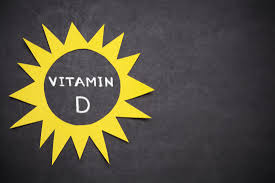
Vitamin D is not really a vitamin
Vitamin D is essential for good bone health and for most people sunlight is the most important source of vitamin D. The time required to make sufficient vitamin D varies according to a number of environmental, physical and personal factors, but is typically short and less than the amount of time needed for skin to redden and burn. Enjoying the sun safely, while taking care not to burn, can help to provide the benefits of vitamin D without unduly raising the risk of skin cancer.
So what is vitamin D?
Vitamin D is not an essential nutrient, classically defined as any substance that we must consume in our diet because we cannot make it adequately on our own. Our skin can make vitamin D from ultraviolet B (UVB) radiation in sunlight. In fact, very few foods even contain vitamin D naturally. Fish liver, mushrooms, certain types of fish and a few other foods contain some vitamin D. Cow’s milk has been artificially supplemented with vitamin D. It is often considered a nutritional issue because if you don’t get enough from sun exposure, you can eat vitamin D and absorb it through your gastrointestinal tract.
Why is vitamin D important?
Vitamin D deficiency has been linked to cancers, multiple sclerosis, frailty, falls, and many other ailments (1). However, there have not been consistent results that show that supplementing with vitamin D in a pill actually does anything useful for chronic diseases(2). Vitamin D has been shown in the some studies to slightly reduce the risk of falls, especially in deficient people (for example, institutionalised older adults) (3). And whilst I currently advise clients to take a vitamin D supplement, I am open to further research on the efficacy of this. For the time being, I personally take a Veg-1 supplement from the Vegan Society which contains 20µg (micrograms) of vitamin D3*. This amount is considered to represent 200-400% of the minimum recommended daily dose, depending on which advice you follow, of course. At the moment there is some variation between the views of eminent doctors such as Dr Michael Greger, who currently advocates vitamin D supplementation, and the like of Dr John McDougall and Prof. T Colin Campbell who are somewhat less convinced about vitamin D supplementation. This is a subject that you can be sure I will revisit in future blogs…
*Non-animal derived Vegan Society vitamin D3 (cholecalciferol) comes from lichen. Vitamin D2 (ergocalciferol) is also non-animal derived and is a compound produced by irradiating yeast with ultraviolet light. “Studies have consistently shown that, functionally, vitamin D3 is at least 300% more effective than D2. … Vitamin D3 supplementation has also been shown to maintain serum vitamin D levels in the long run, especially in the winter months when sunlight is scarce.” (6)
How much sun do I need?
Factors that make a difference in how much vitamin D you make include skin colour (the darker your skin colour the less you make), time of day, length of day, and skin covering, including sunblock. Some sources say that if you have exposure to the midday sun (between 10 a.m. to 3 p.m.) for 5-30 minutes twice a week on the arms and legs you would get sufficient vitamin D(4). For pale skin you might need as little as five minutes, and for dark skin you might require at least 30 minutes. It’s important to note that you can make vitamin D even on cloudy days. Clouds, shade, and severe pollution/smog clouds reduce vitamin D synthesis by about 50-60%(1) yet you’ll still be making vitamin D. Windows block UVB radiation but not all of the ‘tanning’ radiation, UVA, so you won’t make any vitamin D driving in a car unless the windows are down. Sunblock of any SPF strong enough to stop a sunburn will stop almost entirely all vitamin D synthesis(5)on the skin to which it is applied.
Populations most at risk of vitamin D deficiency
Severe vitamin D deficiency causes rickets and osteomalacia, which are problems with bone mineralisation resulting from inadequate calcium and phosphorus. Vitamin D helps with calcium absorption in the intestine. Very low vitamin D causes very low calcium absorption, which triggers other changes including low phosphorus and hormone system changes. Rickets and osteomalacia are uncommon but they are very real risks for certain populations. Populations at risk are included in Table 1.
Table 1
Populations at risk of vitamin D deficiency (darker skin pigment increases risk across all groups)(4)
Mild to moderate risk of vitamin D deficiency:
- People dwelling at northern latitudes, during winter months.
- Elderly (they are able to make less vitamin D)
- Obese
- Those taking certain medications (anticonvulsants, steroids, AIDS therapy)
Moderate to high risk of having vitamin D deficiency:
- Institutionalised people (nursing home residents, for example)
- Women who for religious reason cover all of their skin
- Exclusively breastfed infants
- Those people with certain kidney or liver diseases
- Endocrine disease (thyroid and parathyroid problems), as well as some other ‘granulomatous’ disease (sarcoidosis, tuberculosis, lymphomas)
People who should be concerned about possible vitamin D insufficiency include institutionalised people, people living in the northern US/Europe or at higher latitudes who have long winters, and exclusively breastfed infants and their mothers. Exclusively breastfed infants should take vitamin D, at a level of 400 IU/10µg day. This can be administered as a droplet placed in the baby’s mouth. Those individuals over the age of nine who fall into these categories should take 600 IU/15µg of vitamin D a day while elderly institutionalised people should take 800 IU/20µg per day. Keep in mind that more is not better. It is possible to have too much vitamin D. The maximum adult dose is 4000 IU/100µg per day, and it is significantly lower for children.
Should I regularly check my vitamin D levels and/or see my GP?
There do not appear to be any recommendations based on unequivocal scientific evidence, but Dr Thomas Campbell offers the following guidelines. He checks vitamin D levels on those individuals with calcium, bone or parathyroid hormone problems and will also often screen those people in the categories from Table 1 as well as pregnant or breastfeeding women. For those not in a higher risk category, he does not suggest routine vitamin D screening. Rather, he simply encourages everyone to get as much outdoor time as possible while strictly avoiding any sunburn, along with weight bearing exercise for good bone health. However, he does suggest a vitamin D supplement of 600IU/15µg a day for both adolescents and adults during the winter months .

Dr Michael Greger’s view on this issue:
[youtube https://www.youtube.com/watch?v=DnQwcmmCu8k&w=854&h=480]
Joe’s Additional Comment
As is common with nutrition-related issues, there are few easy answers. However, the safest way of ensuring optimal health is shown repeatedly to be achieved through eating a whole food plant-based diet, avoiding added oils, salt and sugar, keeping away from all that processed junk, taking regular exercise, sleeping well and avoiding unnecessary stress. Contact me for help in designing you own Wholistic WFPB Programme.
N.B. I always recommend discussing this and other medical issues with your GP before making any major dietary changes or taking supplements of any kind.
References
- Dietary Supplement Fact Sheet: Vitamin D. Office of Dietary Supplements, 2011. (Accessed April 15th, 2012, at http://ods.od.nih.gov/factsheets/vitamind-HealthProfessional/.)
- IOM (Institute of Medicine). Dietary Reference Intakes for Calcium and Vitamin D. Washington, DC: The National Academies Press; 2011.
- Holick MF, Binkley NC, Bischoff-Ferrari HA, et al. Guidelines for preventing and treating vitamin D deficiency and insufficiency revisited. J Clin Endocrinol Metab 2012;97:1153-8.
- Holick MF. Vitamin D deficiency. The New England journal of medicine 2007;357:266-81.
- Misra M, Pacaud D, Petryk A, Collett-Solberg PF, Kappy M. Vitamin D deficiency in children and its management: review of current knowledge and recommendations. Pediatrics 2008;122:398-417.
- Lehmann U1, Hirche F, Stangl GI, Hinz K, Westphal S, Dierkes J. Bioavailability of vitamin D(2) and D(3) in healthy volunteers, a randomized placebo-controlled trial. J Clin Endocrinol Metab. 2013 Nov;98(11):433945. doi: 10.1210/jc.20124287. See https://www.globalhealingcenter.com/natural-health/vitamin-d3-vs-vitamin-d2/ for additional details,

